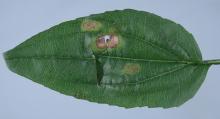Cause The OSU Plant Clinic has found Alternaria sp. and Ulocladium sp. from leaf spot samples. Botrytis sp. was also found from necrotic leaves and stem lesions. White rust, Pustula sp. (formerly Albugo), has been reported in Washington. Generally, weather or irrigation that keeps leaves wet for extended periods favors these diseases.
Symptoms Alternaria alternata - Small dark-brown-to-black, circular leaf spots frequently located on the tips and margins of old leaves. Eventually leaves may turn brown and die.
White rust - white pustules on the undersides of leaves that increased in number and coalesced by the end of the season. Older leaves may have oospores embedded in leaf tissue surrounding pustules.
Cultural control
- Space plants for good air circulation.
- Keep leaves dry by avoiding overhead irrigation or timing irrigation so leaves dry quickly.
- Remove and destroy infected leaves and leaf debris.
Chemical control
- Avelyo at 3 to 5 fl oz/100 gal water. Group 3 fungicide. 12-hr reentry.
- Badge X2 at 1.5 to 2 lb/A. Group M1 fungicide. 48-hr reentry. O
- Orkestra at 4 to 10 fl oz/100 gal water. Group 7 + 11 fungicide. 12-hr reentry.
- Pageant at 4 to 12 oz/100 gal water. Do not use with organosilicone-based adjuvants. Group 7 + 11 fungicide. 12-hr reentry.
References du Toit, L.J. and Derie, M.L., 2014. White Rust of Echinacea angustifolia and E. purpurea in North America Caused by a Pustula Species. Plant disease, 98:856.
Gilardi, G., Matić, S., Gullino, M.L. and Garibaldi, A. 2018. A new leaf spot of Echinacea purpurea caused by Alternaria alternata. Protezione delle Colture, (5), pp.17-19.


